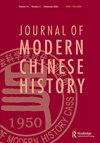IF 0.1
4区 历史学
Q4 HISTORY
引用次数: 0
摘要
1927年至1934年是中国苏维埃革命兴衰起伏的时期;一方面是社会工程运动,如在中国苏区进行的土地改革。其中,阶级这一原本从纯粹马克思主义舶来的思想理论概念,被运用到中国本土社会。相应地,中国苏维埃政权改变了土地革命的方式,即从“针对地方地主并占有他们的财富”转变为一套以“举行群众大会并指定阶级标签”为中心的程序和惯例。关于土地革命的既有文献一般将“阶级”视为某种标准或一种客观的社会现实,研究人员往往以此判断某些土地改革政策处于“过于激进”到“过于保守”的范围内。然而,他们在很大程度上忽略了“阶级”概念被嫁接到中国当地社会(包括农村和城市)的过程细节。本文通过对中央苏区土地革命和阶级划分的历史记录的梳理和分析,考察了“阶级”是如何从纯粹的理论概念演变为具体政策的。通过这样做,它让我们明白了结构性因素的重要性,这些因素对我们理解中国共产主义革命的内在逻辑至关重要。本文章由计算机程序翻译,如有差异,请以英文原文为准。
Uses of the concept of “class” in the Chinese communist revolution: a study of the land reform undertaken in the Chinese Soviet area led by Mao Zedong
ABSTRACT The period between 1927 and 1934 witnessed a waxing and waning of the Chinese Soviet revolution; one aspect of it was the social engineering campaigns, such as the Land Reform carried out in the Chinese Soviet Area. In it, the concept of class, originally an imported ideological and theoretical concept from pure Marxism, was applied to China’s local society. Correspondingly, the Chinese Soviet regime changed its approach to the Land Revolution (tudi geming), i.e. from “targeting local landlords and appropriating their wealth” to a set of procedures and routines centered on “holding mass meetings and designating class labels.” Established literature on the Land Revolution generally treats “class” as a certain criterion or a kind of objective social reality, based on which researchers tend to judge certain land reform policies as having been on a spectrum from “too radical” to “too conservative.” However, they largely ignore the details of the process through which a “class” concept was grafted onto China’s local society – both rural and urban. By taking stock of and analyzing historical records regarding the land revolution and class categorization in the Central Soviet Area, this article examines how “the class” evolved from such a purely theoretical concept to specific policies. By so doing, it drives home the importance of structural factors that are critical to our understanding of the internal logic of the Chinese Communist revolution.
求助全文
通过发布文献求助,成功后即可免费获取论文全文。
去求助

 求助内容:
求助内容: 应助结果提醒方式:
应助结果提醒方式:


